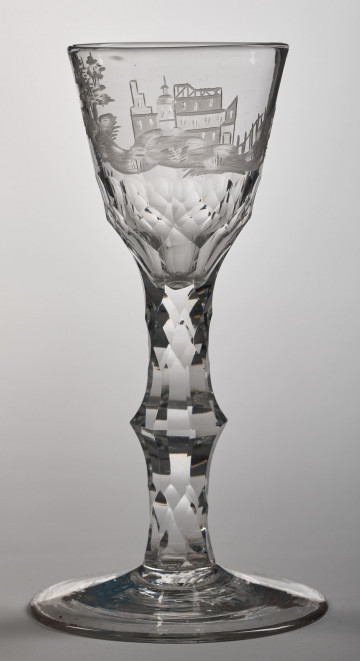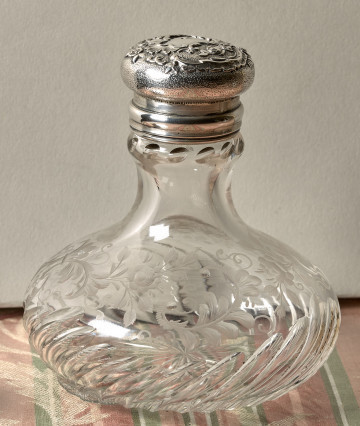
Glass with a castle motif
18th century
Castle Museum in Łańcut
Part of the collection: Goldsmiths
Flask Perfumed water flask from the museum collection, of crystal glass and silver, partly gilded, made in Vienna between the end of the 19th and the beginning of the 20th centuries. The flask is cylindrical, in the upper part forming a short neck with a cap. The wall glass is decorated with vertical ground ribbing in the upper part, and a triple band of ground grooves, additionally decorated with four crosses, spaced equally apart. The neck bears an additional sheet silver ring. The neck is closed with a small glass stopper and a round silver cover. The flask cover is decorated around the edge with a pearl ornament band, inside it is galvanically gilded. The cover and side of the neck carry embossed gilder marks. Galvanic silver-coating or gilding entails placing a metal object (most commonly silver, later – nickel) in a container with a solution of silver or gold salts, and deposition of pure silver or gold using electric current, with these metals becoming a thin coat on the item. Such accessories, like powder containers, flasks for perfume and grooming waters, cream boxes, nail files, scissors, brushes, constituted the necessary equipment of the dressing table of the lady of the house. They were frequently made of crystal glass, silver and gilded silver, as well as richly decorated; they were frequently manufactured by famous gilders and appreciated artists. Possession of these indicated the status of the lady of the house. Perfume flasks were frequently designed by the most famous glasswork artists. Flasks and boxes are a very old invention; in the beginning, clay items were used, later glass- and porcelain ware was added, frequently decorated with precious stones. When the perfume ran out, the lady would send her servant to a goods store, where the flasks were filled with the right perfume. As time went by, the flasks started taking on various shapes and were frequently used for individual orders. With the advent of mass production, the flasks started to be mass-produced in cheap material and uniform shapes.
Dimensions
height: 12.1 cm
Object type
Goldsmithing
Technique
tempering
Material
silver, glass
Creation time / dating
Owner
Castle Museum in Łańcut
Identification number
Location / status

18th century
Castle Museum in Łańcut

1920
Castle Museum in Łańcut

1920
Castle Museum in Łańcut
DISCOVER this TOPIC
National Museum in Szczecin
DISCOVER this PATH
Educational path